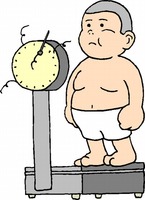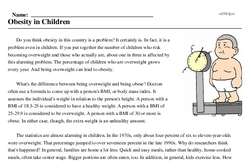Obesity in Children
Do you think obesity in this country is a problem? It certainly is. In fact, it is a problem even in children. If you put together the number of children who risk becoming overweight and those who actually are, about one in three is affected by this alarming problem. The percentage of children who are overweight grows every year. And being overweight can lead to obesity.
What's the difference between being overweight and being obese? Doctors often use a formula to come up with a person's BMI, or body mass index. It assesses the individual's weight in relation to the person's height. A person with a BMI of 18.5-25 is considered to have a healthy weight. A person with a BMI of 25-29.9 is considered to be overweight. A person with a BMI of 30 or more is obese. In either case, though, the extra weight is an unhealthy amount.
The statistics are almost alarming in children. In the 1970s, only about four percent of six to eleven-year-olds were overweight. That percentage jumped to over seventeen percent in the late 1990s. Why do researchers think that's happened? In general, families are home a lot less. Quick and easy meals, rather than healthy, home-cooked meals, often take center stage. Bigger portions are often eaten, too. In addition, in general, kids exercise less. How come? Many of them have filled their hours with more sedentary activities like TV, video games, and computer time. Eating too much and exercising too little equals overweight people.




